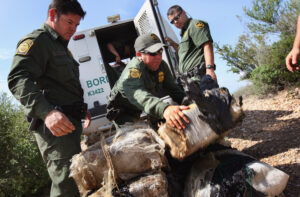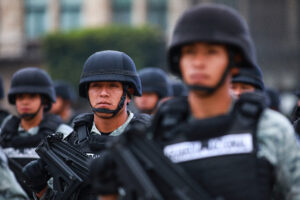WASHINGTON– The Washington Office on Latin America (WOLA) will follow President Obama’s visit to Mexico on April 16-17 and will be available to provide analysis on the issue. Next week, WOLA will provide commentary on the Obama and Calderon Administrations’ efforts to quell drug trafficking and violence in Mexico and provide background to this analysis from a historic perspective, highlighting lessons learned from similar efforts in Mexico’s past.
In addition, WOLA will publish a study that shows that while cocaine prices have fluctuated, US cocaine prices continued to fall through 2007, while purity remained high, making it clear that while market disruption will occur and prices will spike during certain periods, cocaine supply has remained quite robust despite years of pursuing aggressive and costly policies aimed at curtailing cocaine availability.
Please find below some points you might want to touch on during your coverage of next week, as well as a list of reference materials on US-Mexico security cooperation:
1. Mexico’s capacity to investigate and prosecute criminals
The ability to identify, prosecute, and punish drug traffickers is a key element in containing the drug trade. There were over 10,000 drug-related killings in Mexico in the past three years. As staggering as these numbers are, it is noteworthy that the majority of these murders may never be solved. The Mexican Citizen Institute for Research on Insecurity (INCESI) found that initial investigations are begun for only 13% of the reported crimes and in only 5% of these crimes are the alleged perpetrator brought before a judge. (1) The same institute estimates that of every 100 investigations, only 4 cases result in sentencing the person responsible.
The persistence of corruption and impunity within Mexico’s criminal justice system perpetuates drug trafficking and the violence that comes with it and leads to human rights abuses. Mexico will not overcome the threats of the cartels until it can ensure efficient investigations and the adequate collection of evidence. The Obama Administration should support for Mexico’s efforts to overhaul its judiciary system. Given the extent of the judicial reforms being undertaken, which entail a transformation from an inquisitorial to an adversarial system based on oral trials, the Mexican government has established an eight year transition period. US support for these reform efforts could include: revamping law school curriculums and text books; exchange programs for judges and lawyers to countries experiencing similar transformations; programs to strengthen Mexico’s judicial work in the areas of evidence handling and chain of custody; equipment and training for expert services (ballistics, criminology); and victim and witness protection and restitution programs as an essential component for effective criminal investigations.
2. Police reform efforts
A lack of accountability and corruption in the Mexican police forces continues to plague the public security system. A January 2009 tally by the Mexican newspaper Reforma reports that in 2008, 759 police in 16 states were arrested, most of them due to ties to drug trafficking organizations.(2) Operation Clean-up (Operativo Limpieza), launched in November of last year by Mexico’s Attorney General’s Office (Procuraduría General de la República, PGR), detained numerous Mexican officials for their links to organized crime, including members of the President’s security team, the former director and other agents from the federal organized crime unit (SIEDO), and two former directors of Interpol Mexico’s office. The recently released 2007 National Audit of Mexico’s federal government reports that in cities with over 100,000 residents, the crime rate is actually greater where there is a higher number of police.(3)
The Calderon administration has adopted several measures to vet Mexico’s police forces and establish centers that carry out annual reviews of police performance utilizing a series of evaluations. However, according to the Office of Control and Confidence within the Public Security Ministry (Secretaría de Seguridad Pública, SSP), which evaluated 56,065 officers in 2008 – approximately 15% of the police in Mexico – 41.7% were found to be “recommendable,” and 49.4% were “not recommendable.”(4)
The Obama Administration should explore ways for the United States to support and strengthen Mexico’s efforts to evaluate police performance at the federal, state, and local levels. The United States recently took a step in this direction by providing $3 million, through the Merida Initiative, to assist Mexico in making its national police registry fully operational. This is important because without a complete national police registry and an established consultation mechanism, there is no way to verify the service record, educational background, places of employment, etc. of the police (federal, state, and local), impeding thorough background checks and vetting processes. This is essential so that police officers sanctioned or removed from one entity because of corruption or abuse, are not simply rehired by another.
3. Drug consumption in the US
One of the most important things the United States can do to help Mexico cope with drug-related violence is to reduce US demand for drugs, especially through proven strategies such as treatment for heavy users. As described in a forthcoming WOLA paper on cocaine price trends, the latest available data from the White House Office of National Drug Control Policy (ONDCP) show that US cocaine prices continued to fall through 2007, while purity remained high.(5) Although 2008 data is not available, historic trends make it clear that while market disruption will occur and prices will spike during certain periods, cocaine supply has remained quite robust despite years of pursuing aggressive and costly policies aimed at curtailing cocaine availability.(6) The inability to control supply underscores the need to do more to address demand.
The Obama administration has an important opportunity to rethink US drug policy, including providing additional resources for demand-side strategies such as treatment. The affirmation by Gil Kerlikowske at his Senate nomination hearing to head the ONDCP, that “There will be a renewed focus on evidenced-based approaches to reduce demand for drugs, through prevention as well as treatment” suggests that important policy changes may be on the way.(7) Nonetheless, substantial reductions in the size of the illicit drug market should not be expected any time soon. Therefore, the key to a more effective policy is to realize that drug-related problems cannot be eliminated, but they can certainly be managed better than the US has done to date. This entails a harm reduction approach, which seeks to minimize the harms associated with illicit drug production, distribution, and abuse, and the harms generated by policies meant to control drugs.
4. Military caliber weapons trafficking
The Bureau of Alcohol, Tobacco, Firearms and Explosives (ATF) estimates that approximately 90% of the weapons confiscated by the Mexican government in their counter-drug operations originated in the United States. Lax laws and regulations governing the firearms industry at the local, state, and federal levels, and the weak or ineffective enforcement of these laws, facilitate gun trafficking into Mexico.
The Obama Administration should ensure a strict enforcement by the ATF of the existing ban on the importation of semiautomatic assault weapons and step up efforts by the ATF to identify and sanction Federal Firearms License holders who are the sources of many of the weapons trafficked into Mexico.
Other important action
s to stem the flow of trafficked arms into Mexico include legislative measures to expand mandatory background checks for personal gun sales, particularly sales made at gun shows, and the implementation of an effective federal assault weapons ban.
As security cooperation broadens between Mexico and the United States, attention and resources for long-term reforms in the Mexican police and justice sector are needed to deal effectively with the inter-related problems of illicit drugs, crime, and violence. Likewise, while strengthening Mexico’s institutions is vital, this must be accompa¬nied by efforts to curb drug consumption in the United States and crack down on gun sales that fuel illegal arms trafficking into Mexico. President Obama’s visit to Mexico next week is an opportunity to highlight the importance of this common security agenda.
1 Instituto Ciudadano de Estudios sobre la Inseguridad, “Fifth National Survey on Insecurity”, 2007.
http://www.icesi.org.mx/documentos/encuestas/encuestasNacionales/ENSI-5.pdf
2 “Detienen a 759 policías ligados al narco en 2008,” Reforma, January 6, 2009.
3 Executive Summary, Federal Audit of Mexico, http://www.asf.gob.mx/Trans/Obliga/Resumenejec07.pdf pgs. 53-55.
4 Pregunta No. 6, Partido Acción Nacional, Respuestas a las preguntas formuladas en relación con el Segundo Informe de Gobierno. http://gaceta.diputados.gob.mx/Gaceta/60/2008/nov/2PAN.pdf
5 The new price and purity estimates are available in two places on the ONDCP website: the annual estimates are presented in Table 50 of the data supplement to the 2009 National Drug Control Strategy at http://www.whitehousedrugpolicy.gov/publications/policy/ndcs09/ndcs09_data_supl/ds_drg_rltd_tbls.pdf; the quarterly estimates and methodological details are presented in The Price and Purity of Illicit Drugs: 1981-2007, 23 July 2008, prepared for ONDCP by the Institute for Defense Analyses (IDA), at http://www.whitehousedrugpolicy.gov/publications/price_purity/price_purity07.pdf
6 Walsh, John, “Unprecedented Cocaine Shortage? Evidently Not,” Washington Office on Latin America, forthcoming.
7 Testimony of the Honorable R. Gil Kerlikowske before the U.S. Senate Committee on the Judiciary, 1 April 2009, at http://judiciary.senate.gov/hearings/




